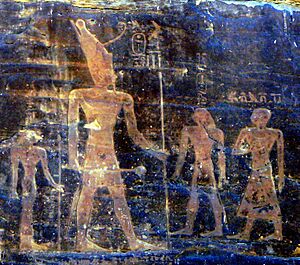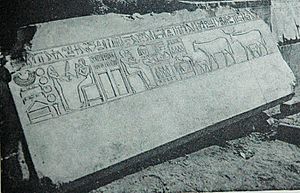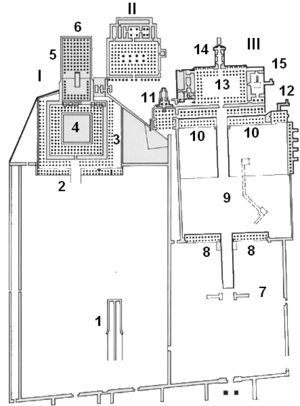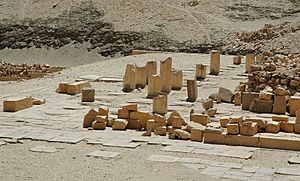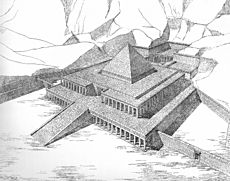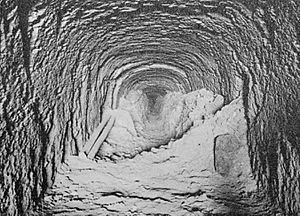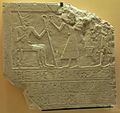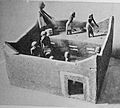Mentuhotep II facts for kids
Quick facts for kids Mentuhotep II |
|
|---|---|

Mentuhotep II on a relief from his mortuary temple in Deir el-Bahari
|
|
| Pharaoh | |
| Reign | 2060–2009 BC (11th Dynasty) |
| Predecessor | Intef III |
| Successor | Mentuhotep III |
| Consort | Tem, Neferu II, Ashayet, Henhenet, Kawit, Kemsit, Sadeh |
| Children | Mentuhotep III, Mayet(?) |
| Father | Intef III |
| Mother | Iah |
| Died | 1995 BC ? |
| Burial | mortuary temple at Deir-el-Bahri |
Mentuhotep II was an ancient Egyptian pharaoh. His name means "Mentu is satisfied." He was also known by his royal name, Nebhepetre, meaning "The Lord of the rudder is Ra." Mentuhotep II was the sixth ruler of the 11th Dynasty.
He is famous for reuniting Egypt. This ended a difficult time called the First Intermediate Period. He became the first pharaoh of the Middle Kingdom. Mentuhotep II ruled for 51 years. He took over from his father, Intef III, and his son, Mentuhotep III, became pharaoh after him.
Mentuhotep II became pharaoh in the city of Thebes in Upper Egypt. At that time, Egypt was split into two parts. The 10th Dynasty ruled Lower Egypt from a city called Herakleopolis. Around his 14th year as pharaoh, the Herakleopolitan kings disrespected a sacred burial ground in Abydos. Mentuhotep II then sent his armies north. He continued the work of his father, Intef III, and successfully brought Egypt back together. This likely happened just before his 39th year on the throne. To celebrate this big achievement, he changed his royal name to Shematawy, which means "He who unifies the two lands."
After uniting Egypt, Mentuhotep II made big changes to the government. He wanted to bring power back to the pharaoh. Before him, local rulers called nomarchs had too much power. Mentuhotep II made Thebes the main center of power. He also created new government jobs and gave them to people loyal to him. Officials from Thebes regularly traveled the country. This helped the pharaoh keep control over all regions.
Mentuhotep II was buried in his mortuary temple at Deir el-Bahari. This temple was one of his most important building projects. It had new designs, like terraces and covered walkways. It was also the first temple to connect the pharaoh with the god Osiris. His temple later inspired other famous temples, like those of Hatshepsut and Thutmose III.
Royal Family
Mentuhotep II was the son of Intef III and Queen Iah. Queen Iah was also known as the "King's mother." This family connection is shown on old stone carvings and records. Some experts have suggested that Mentuhotep II might have had Nubian roots. This is because some images of him show features that look like people from Nubia. Also, the 11th Dynasty rulers were from southern Egypt and had strong ties with Nubia.
Mentuhotep II had several wives. Many of them were buried near his mortuary temple.
- Tem was likely his main wife. She was called "King's wife" and "King's wife, his beloved." She was also called "King's mother," meaning she was the mother of a future pharaoh. Her son was Mentuhotep III. Her tomb was found near Mentuhotep's temple.
- Neferu II was another important wife. She might have been Mentuhotep II's sister. She was buried in a tomb at Deir el-Bahri.
- Kawit was one of his other wives. She was also a priestess of the goddess Hathor. Her sarcophagus (stone coffin) was found under the terrace of Mentuhotep II's temple.
- Sadeh, Ashayet, Henhenet, and Kemsit were also wives of Mentuhotep II. They were all priestesses of Hathor and were buried in pits near his temple.
- Mayet was a young girl, about five years old, buried with his other wives. She was likely one of his daughters.
Mentuhotep II's Rule
Mentuhotep II is seen as the first ruler of the Middle Kingdom of Egypt. Ancient records say he ruled for 51 years.
Early Years as Pharaoh
When Mentuhotep II became pharaoh, he already controlled a large area. This land stretched from the first cataract in the south to Abydos in the north. His first 14 years as ruler seem to have been peaceful. There are no signs of major wars during this time. This might mean he was young when he became pharaoh.
Uniting Egypt
In his 14th year, a rebellion happened in the north. This was part of the ongoing fight between Mentuhotep II's Theban rule and the rival 10th Dynasty in Herakleopolis. The Herakleopolitan kings attacked the sacred burial ground of Abydos. Mentuhotep II then sent his armies to the north.
A famous tomb at Deir el-Bahari holds the bodies of 60 soldiers. They were killed in battle, and their burial cloths had Mentuhotep II's name on them. These soldiers are believed to be heroes who died fighting to unite Egypt. The ruler of Lower Egypt at the time, Merikare, may have died during this conflict. This made his kingdom weaker and helped Mentuhotep unite Egypt.
The exact date Egypt was fully united is not known. But it probably happened just before his 39th year as pharaoh. It took time to bring the country together. Even 20 years later, when his successor sent an expedition, they still had to deal with rebels.

After uniting Egypt, Mentuhotep II was seen as almost divine by his people. This belief continued for hundreds of years. Later pharaohs even performed ceremonies on his statues.
Military Actions Outside Egypt
Mentuhotep II also led military campaigns outside Egypt. His vizier (a high official) Khety led trips south into Nubia. Nubia had become independent during the First Intermediate Period. This was the first time the name "Kush" was used for Nubia in Egyptian records. Mentuhotep placed soldiers at the fortress of Elephantine. This allowed them to quickly send troops south. There is also evidence of military actions against Canaan. An inscription found near modern Libya, Sudan, and Chad mentions the king. This shows that Egypt had trade connections with that region.
Government Changes
Before Mentuhotep II, local rulers called nomarchs had a lot of power. Their positions had become hereditary, meaning they passed down in families. This happened when the central government was weak. After uniting Egypt, Mentuhotep II made the government stronger. He created new positions like "Governor of Upper Egypt" and "Governor of Lower Egypt." These governors had power over the local nomarchs.
Mentuhotep also used royal officials who traveled the country. They kept an eye on the nomarchs. Any nomarchs who had supported the rival 10th Dynasty likely lost their power. Mentuhotep II also started to present himself as a god. This helped him strengthen his royal authority.
Royal Names and Titles
Mentuhotep II's efforts to show his divine power are clear in the temples he built. In these temples, he is shown wearing the crowns of the gods Min and Amun. He was also called the "son of Hathor" later in his rule.
Mentuhotep II changed his royal names and titles twice. The first change was in his 14th year. This marked his early successes against the Herakleopolis rulers. The second change happened around his 39th year. This celebrated his final victory and the full unification of Egypt. This second change might have happened during a special festival called the sed festival.
|
|
|
|
|||||||||||||||
Horus name
|
S.ˁnḫ-ib-tȝwy "Horus, he who invigorates the heart of the two lands" |
Nṯrj-ḥḏt "The divine one of the white crown" |
Šmˁ-tȝ.w(j) "He who unifies the two lands" |
||||||||||||||
Nebty name
|
Nṯrj-ḥḏt "The divine one of the white crown" |
Šmˁ-tȝ.w(j) "He who unifies the two lands" |
|||||||||||||||
Golden Horus name
|
Bjk-nbw-qȝ-šwtj "The Golden Falcon, lofty in plumes" |
||||||||||||||||
Prenomen
|
Nb-ḥpt-Rˁ "The Lord of the rudder is Re" |
Nb-ḥpt-Rˁ "The Lord of the rudder is Re" |
|||||||||||||||
Nomen
|
Mn-ṯw-ḥtp "Montu is satisfied" |
Mn-ṯw-ḥtp "Montu is satisfied" |
Mn-ṯw-ḥtp "Montu is satisfied" |
Mentuhotep II's titles show that he wanted to bring back the traditions of the Old Kingdom. He used a full set of five royal names after uniting Egypt. This was something not seen since the 6th Dynasty. He also sometimes used a name that referred to the goddess Hathor. This was similar to the pharaoh Pepi I from the Old Kingdom.
Mentuhotep II's Monuments
Mentuhotep II ordered many temples to be built. Not many of them survive today. He followed a tradition started by his grandfather, Intef II. Royal building projects in temples in Upper Egypt began with Intef II. Most of the remaining temple parts are in Upper Egypt. These include places like Abydos, Aswan, Karnak, and Denderah.
Mortuary Temple at Deir el-Bahri
| Mortuary Temple of Mentuhotep II in hieroglyphs | |||||||||||||||
|---|---|---|---|---|---|---|---|---|---|---|---|---|---|---|---|
3ḫ-swt-nb-ḥpt-Rˁ AkhsutnebhepetRe "Transfigured are the places of Nebhepetre" |
|||||||||||||||
3ḫ-swt-Jmn Akhsutamun "Transfigured are the places of Amun" |
|||||||||||||||
Mentuhotep II's most important building was his large mortuary temple. It is located at Deir el-Bahri. This temple was very new and different for its time. It broke away from the old pyramid complexes of the Old Kingdom. It also gave ideas for the "Temples of Millions of Years" built later in the New Kingdom. For example, the temples of Hatshepsut and Thutmose III were inspired by Mentuhotep II's design.
The temple's biggest changes were not just in its design, but in its religious ideas. It was the first mortuary temple where the king performed ceremonies for the gods. In this case, it was for Amun-Ra. Also, the temple showed the king as being like the god Osiris. This idea of the dead ruler being like Osiris became common for many pharaohs later on.
Most of the temple's artwork was done by local artists from Thebes. Their style showed people with large lips and eyes, and thin bodies. However, the chapels for Mentuhotep II's wives were made by artists from Memphis. These artists followed the older styles of the Old Kingdom. This mix of art styles shows how Egypt was still divided politically at that time.
Temple Location
The temple is built into the cliff at Deir el-Bahri. This is on the west bank of Thebes. This spot was chosen because the 11th Dynasty came from Thebes. Mentuhotep's ancestors were buried in nearby tombs. Deir el-Bahri also lines up with the Karnak temple across the Nile. The statue of Amun was brought to Deir el-Bahri every year during a festival. The king might have thought this would help his burial cult. So, Mentuhotep II's temple was the final stop for Amun's boat during this festival for many centuries.
Discovery and Excavations
In the early 1800s, Mentuhotep II's temple was completely covered by dirt. People didn't notice it for a long time. Even though they were digging at Hatshepsut's nearby temple, Mentuhotep's temple remained hidden.
In 1859, Lord Dufferin and his team started digging. They found the tomb of Queen Tem, one of Mentuhotep's wives. They realized the site was important and kept digging. They found the sanctuary and Mentuhotep's granite altar. In 1898, Howard Carter found a famous black statue of the king in the front courtyard.
More important digs happened from 1903 to 1907. Henri Édouard Naville led the first full exploration of the temple. Later, from 1920 to 1931, Herbert E. Winlock continued the work. Finally, from 1967 to 1971, Dieter Arnold did more research.
Temple Design
Mentuhotep II's temple complex had two parts. There was a high temple at Deir el-Bahri and a valley temple closer to the Nile. A long, uncovered walkway, about 1.2 km long, connected the two temples. This walkway led to a large courtyard in front of the Deir el-Bahri temple.
The courtyard had a long, rectangular garden. It had 55 sycamore trees and 6 tamarisk trees. This is one of the few ancient Egyptian temple gardens that we know about. Keeping this garden alive in the desert needed many gardeners and a good watering system.
Along the walkway, there were at least 22 seated statues of Mentuhotep II. On the south side, he wore the White Crown of Upper Egypt. On the north side, he wore the Red Crown of Lower Egypt. These statues were probably added for his sed festival in his 39th year. Some headless sandstone statues are still there today. Another statue is in the Metropolitan Museum of Art.
The main temple had two parts. The front part was for the god Monthu-Ra. This god was a mix of the sun god Ra and the Theban war god Monthu. A ramp led up to the temple's upper terrace. The front part of the temple had two porticos (porches) with double rows of pillars. This made the temple look like a "saff tomb," which was the traditional burial style for Mentuhotep II's ancestors.
On the temple terrace, a large platform held the upper hall. This hall surrounded an ambulatory (a curved walkway) and the main building. The ambulatory had 140 octagonal columns in three rows. Most of these columns only have their bases left today.
The center of the temple had a massive building. It was 22 meters wide and 11 meters high. Some experts believe it was a square building topped with a small pyramid. This pyramid might have looked like the royal tombs at Abydos. However, other experts think it had a flat roof because a pyramid would have been too heavy.
Rear Part of the Temple
Behind the main building was the area for worshipping the deified king. This part of the temple was carved directly into the cliff. It had an open courtyard, a hall with 82 columns, and a chapel for a statue of the king. This section of the temple was for Amun-Ra.
The open courtyard had rows of columns. In the middle of the courtyard was a deep, 150-meter-long corridor. This corridor led down to a large underground chamber. This chamber, 45 meters below the courtyard, was the king's tomb. The tomb chamber was lined with red granite and had a pointed roof. It once held an alabaster chapel and a wooden coffin. Most of the valuable items from the tomb were stolen long ago. Only a few things remained, like a scepter, arrows, and models of ships and bakeries.
Images for kids
-
Painted sandstone seated statue of Nebhepetre Mentuhotep II, Egyptian Museum, Cairo.
-
Painted sandstone statue of Mentuhotep II wearing the Deshret crown, discovered by H. Winlock.
-
Head statue of Mentuhotep II originally in Thebes, now on display in the Museo Gregoriano Egiziano, Vatican.
-
Mentuhotep II receives offering, Musée du Louvre.
-
Cylinder seals of Mentuhotep II, Musée du Louvre.
-
Mentuhotep II's cartouche on the Abydos king list.
See also
 In Spanish: Mentuhotep II para niños
In Spanish: Mentuhotep II para niños


